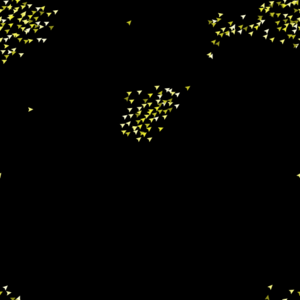“Flocking”的版本间的差异
(建立内容为“此词条属于NetLogo模型汇总项目。 原文链接: 缩略图 http://ccl.northwestern.edu/netlogo/models/Flocking == WHAT IS…”的新页面) |
(没有差异)
|
2022年4月15日 (五) 17:54的版本
此词条属于NetLogo模型汇总项目。
原文链接:
http://ccl.northwestern.edu/netlogo/models/Flocking
WHAT IS IT(鸟群模型)
This model is an attempt to mimic the flocking of birds. (The resulting motion also resembles schools of fish.) The flocks that appear in this model are not created or led in any way by special leader birds. Rather, each bird is following exactly the same set of rules, from which flocks emerge.
这是一个模拟鸟群运动的模型(该模型的运动规律也也很像鱼群)。在这个模型中出现的鸟群运动规律并不是由特殊的或某一个领头鸟创造的,相反,每只鸟都遵循一套完全相同的规则,从而形成了鸟群的运动。
HOW IT WORKS(运行规则)
The birds follow three rules: "alignment", "separation", and "cohesion".
"Alignment" means that a bird tends to turn so that it is moving in the same direction that nearby birds are moving.
"Separation" means that a bird will turn to avoid another bird which gets too close.
"Cohesion" means that a bird will move towards other nearby birds (unless another bird is too close).
When two birds are too close, the "separation" rule overrides the other two, which are deactivated until the minimum separation is achieved.
The three rules affect only the bird's heading. Each bird always moves forward at the same constant speed.
每一只鸟遵循三条规则:“对齐alignment”、“分离separation”和“靠近cohesion”。
- “对齐”指的是鸟会倾向于转向,这样它的移动方向与附近的鸟的移动方向相同。
- “分离”指的是如果另外一只鸟靠的太近,鸟会转身避开。
- “靠近”意味着一只鸟会向附近的其他鸟移动(除非另一只鸟离得太近)。
当两只鸟靠得太近时,“分离”规则会占据主导,直到达到一个最小的可接受的距离。
这三条规则只影响鸟的向前运动方向,每只鸟总是以同样恒定的速度向前移动。
HOW TO USE IT(使用教程)
First, determine the number of birds you want in the simulation and set the POPULATION slider to that value. Press SETUP to create the birds, and press GO to have them start flying around.
The default settings for the sliders will produce reasonably good flocking behavior. However, you can play with them to get variations:
Three TURN-ANGLE sliders control the maximum angle a bird can turn as a result of each rule.
VISION is the distance that each bird can see 360 degrees around it.
- 首先,确定您想要在模拟中的鸟群数量,并将POPULATION滑块设置为该值。
- 按SETUP键创建,然后按GO键让它们开始飞行。
- 滑动块的默认设置可以产生效果不错的群集行为。
- 不过你可以调整来改变其运动:
- 三个转角滑块TURN-ANGLE控制鸟的最大转弯角度。
- VISION 视力是每只鸟能360度看到的距离。
THINGS TO NOTICE(注意事项)
Central to the model is the observation that flocks form without a leader.
There are no random numbers used in this model, except to position the birds initially. The fluid, lifelike behavior of the birds is produced entirely by deterministic rules.
Also, notice that each flock is dynamic. A flock, once together, is not guaranteed to keep all of its members. Why do you think this is?
After running the model for a while, all of the birds have approximately the same heading. Why?
Sometimes a bird breaks away from its flock. How does this happen? You may need to slow down the model or run it step by step in order to observe this phenomenon.
该模型的要点是在于观察到鸟群在没有领导者的情况下的形成。
在这个模型中没有使用随机数,除了鸟类的初始位置。鸟群的流动、栩栩如生的行为完全是由确定性规则产生的。
另外,请注意每个鸟群都是动态的。一个鸟群,一旦聚集在一起,并不能保证能留住所有的成员。你认为这是为什么?
运行模型一段时间后,所有的鸟都有大致相同的方向。为什么?
有时鸟儿会从鸟群中飞走。这是怎么发生的?为了观察这种现象,您可能需要放慢模型的速度或一步一步地运行它。
THINGS TO TRY(你可以试一试)
Play with the sliders to see if you can get tighter flocks, looser flocks, fewer flocks, more flocks, more or less splitting and joining of flocks, more or less rearranging of birds within flocks, etc.
You can turn off a rule entirely by setting that rule's angle slider to zero. Is one rule by itself enough to produce at least some flocking? What about two rules? What's missing from the resulting behavior when you leave out each rule?
Will running the model for a long time produce a static flock? Or will the birds never settle down to an unchanging formation? Remember, there are no random numbers used in this model.
调整滑块看看能不能得到更紧密的鸟群,更松散的鸟群,更少的鸟群,更多的鸟群,或多或少的鸟群分裂或合并,或多或少的鸟群内的鸟类重新排列,等等等等。
你可以通过将该规则的角度滑块设置为0来完全关闭该规则。一条规则本身是否足以产生至少一些群体?那两条规则呢?当您删除每个规则时,结果行为中缺少了什么?
长时间运行该模型是否会产生静态鸟群?或者这些鸟群永远不会安于一个不变的队形?记住,这个模型中没有随机数。
EXTENDING THE MODEL(模型的延伸)
Currently the birds can "see" all around them. What happens if birds can only see in front of them? The in-cone primitive can be used for this.
Is there some way to get V-shaped flocks, like migrating geese?
What happens if you put walls around the edges of the world that the birds can't fly into?
Can you get the birds to fly around obstacles in the middle of the world?
What would happen if you gave the birds different velocities? For example, you could make birds that are not near other birds fly faster to catch up to the flock. Or, you could simulate the diminished air resistance that birds experience when flying together by making them fly faster when in a group.
Are there other interesting ways you can make the birds different from each other? There could be random variation in the population, or you could have distinct "species" of bird.
目前,这些鸟可以“看到”周围的一切。如果鸟类只能看到前方会发生什么?可以用in-cone设置。
有没有什么方法能让鸟群变成V形,比如迁徙的大雁的形态?
如果你在世界的边缘设置围墙,鸟儿飞不进去会发生什么?
你能让鸟儿飞过世界中央的障碍物吗?
如果给鸟儿不同的速度会发生什么?例如,你可以让远离其他鸟儿的鸟飞得更快,从而赶上鸟群。或者,你可以模拟鸟群在一起飞行时经历的空气阻力减小,方法是让它们在群体中飞得更快。
你觉得还有其他有趣的方式可以让这些鸟彼此不同吗?种群中可能存在随机变异,也可能存在不同的“物种”。
